Page 312 of 410

Inflation -- Tire Pressure
The Certificationnire label, which is on the driver’s door
edge, above the door latch, shows the correct inflation
pressures for your tires when they’re cold. “Cold” means
your vehicle has been sitting
for at least three hours
or driven no more than
1 mile (1.6 km).
Notice: Don’t let anyone tell you that underinflation
or overinflation
is all right. It’s not. If your tires
don’t have enough air (underinflation), you can get
the following:
0 Too much flexing
Too much heat
0 Tire overloading
Bad wear
0 Bad handling
0 Bad fuel economy
If your tires have too much air (overinflation), you
can get the following:
0 Unusual wear
0 Bad handling
0 Rough ride
Needless damage from road hazards
When to Check
Check your tires once a month or more.
Also, check the tire pressure of the spare tire.
Use a good quality pocket-type gage to check tire
pressure.
You can’t tell if your tires are properly inflated
simply by looking at them. Radial tires may look
properly inflated even when they’re underinflated.
Be sure
to put the valve caps back on the valve stems.
They help prevent leaks by keeping
out dirt and moisture.
Tire Inspection and Rotation
Tires should be rotated every 7,500 miles (12 500 km).
Any time you notice unusual wear, rotate your tires
as soon as possible and check wheel alignment.
Also
check for damaged tires or wheels. See When It Is Time
for New Tires
on page 5-55 and Wheel Replacement
on page 5-58 for more information.
Make sure the spare tire
is stored securely. Push, pull,
and then try
to rotate or turn the tire. If it moves,
use the wheel wrench to tighten the cable. See
Changing a Flat Tire on page 5-62.
5-53
Page 323 of 410
The tools you'll be using include the wheel wrench (A),
tire blocks (B), extension (socket end) (C), handle
(jack end)
(D), and jack (E).
The following instructions explain how to remove the
spare tire mounted underneath your vehicle.
Notice: Never remove or restow a tire from/to a
storage position under the vehicle while the vehicle
is supported by a jack. Always tighten the tire
fully against the underside
of the vehicle when
restowing.
f
1. To remove the underbody-mounted spare, insert
the socket end of the extension on a
45" angle
downward into the hoist drive shaft hole. This will
be exposed when the rear gate is open and is
just above the rear bumper. Be sure the socket end
of the extension connects into the hoist shaft.
5-64
Page 324 of 410
2. Turn the wheel wrench counterclockwise to lower
the spare tire. Keep turning the wheel wrench until
the spare tire can be pulled out from under the
vehicle.
If the spare tire does not lower to the ground, the
secondary latch is engaged causing the tire
not to lower. See “Secondary Latch System” later in
this section.
When the tire has been completely lowered, tilt the
retainer at the end of the cable and pull it through
the wheel opening. Pull the tire out from under
the vehicle.
Notice:
To help avoid vehicle damage, do not drive
the vehicle before the cable is restored.
3. Put the spare tire near the flat tire.
4. Position the chisel end of
your wheel wrench in the
notch of the center
cap and pry
off the
center cap.
See “Removing the Flat Tire and Installing the Spare
Tire” later in this section to continue changing the flat tire.
5-65
Page 326 of 410

1. Check under the vehicle
to see
if the cable is
visible.
2. If it is not visible, proceed to Step 6.
If visible, first try to tighten the cable by turning the
wheel wrench clockwise until you hear two clicks
or feel it skip twice. You cannot overtighten
the cable.
3. Loosen the cable by turning the wheel wrench
counterclockwise three or four turns.
4. Repeat this procedure at least two times.
If the spare tire lowers to the ground, continue with
Step
2 of “Removing the Spare Tire and Tools”
earlier in this section.
approximately
6 inches (15 cm) of cable is exposed.
5. Turn the wrench counterclockwise until
6. Attach the jack handle, extension and the wheel
wrench to the jack and place it under the vehicle
towards the front of the rear bumper. Position
the center lift point of the jack under the center of
the spare tire.
7. Turn the wrench clockwise to raise the jack until it
lifts the end fitting.
8. Continue raising the jack until the spare tire stops
moving upward and is held firmly in place. The
secondary latch has released and the spare tire is
balancing on the jack.
5-67
Page 327 of 410

9.
10. Lower the jack by turning the wheel wrench
counterclockwise. Keep lowering the jack until the
spare tire slides
off the jack or is hanging by
the cable.
Disconnect the jack handle from the jack and
carefully remove the jack. Use one hand to push
against the spare while firmly pulling the jack out
from under the spare tire with the other hand.
If the spare tire is hanging from the cable, insert the
jack handle, extension and wheel wrench into the
hoist shaft hole in the bumper, on an angle, and turn
the wheel wrench counterclockwise
to lower the
spare the rest of the way.
11. Tilt the retainer at the end of the cable and pull it
through the wheel opening. Pull the tire out from
under the vehicle.
12. If the cable is hanging under the vehicle, turn the
wheel wrench in the hoist shaft hole in the bumper
clockwise to raise the cable back up.
Have the hoist assembly inspected as soon as you can.
You will not be able to store a spare or flat tire using
the hoist assembly until it has been repaired or replaced.
5-68
Page 328 of 410
Removing the Flat Tire and Installing
the Spare Tire
'- 1. Using the wheel wrench,
loosen all the wheel nuts.
Don't remove them yet.
Front
2. Turn the jack adjusting knob clockwise by hand to
3. Place the handle, extension and wheel wrench onto
raise the
jack lift head.
the jack.
5-69
Page 330 of 410
5. Raise the vehicle by turning the jack handle
clockwise. Raise the vehicle far enough
off the
ground
so there is enough room for the spare
tire to fit.
6. Remove all the wheel nuts and take off the flat tire.
7. Remove any rust or dirt
from the wheel
bolts,
mounting surfaces
and spare wheel.
Is--- -
Rust or dir n t ---lee-, 3r 4 the p. s to
which
it is fastened, can make the wheel nuts
become loose after
a time. The wheel could
come
off and cause an accident. When you
CAUTION: (Continued) change a
wheel, remove any rust or dirt from
the places where the wheel attaches
to the
vehicle. In an emergency, you can use a cloth
or a paper towel to do this;
but be sure to use
a scraper or wire brush later, if you need to, to
get all the rust or dirt
off.
1
Never use oil or grease on studs tan nnutS. If
you do, the nuts might come loose. Your wheel
could fall
off, causing a serious
8. Place the spare on the wheel mounting surface.
5-71
Page 333 of 410

Storing 9 Flat or Spare Tire and Tmls
n
Storing a jack, a tire, or other equipment in the
passenger compartment of the vehicle could
cause injury.
In a sudden stop or collision,
loose equipment could strike someone. Store
all these in the proper place.
.
The underbody-mounted spare tire needs to be
stored with the valve stem pointing up. If the
spare tire is stored with the valve stem
pointing downward,
its secondary latch won’t
work properly and the spare tire could loosen
CAUTION: (Continued)
CAUTION: (Continued,
and suddenly fall from your vehicle. If this
happened when your vehicle was being driven,
the tire might contact a person or another
vehicle, causing injury and, of course, damage
to itself as well. Be sure the underbody-
mounted spare tire
is stored with its valve
stem pointing up.
Notice: An aluminum wheel with a flat tire should
always be stored under the vehicle with the hoist. However, storing
it that way for an extended
period could damage the wheel. To avoid this,
always stow the wheel properly with the valve stem
pointing up and have the wheel repaired as soon
as possible.
Follow this diagram to store the underbody-mounted
spare.
5-74